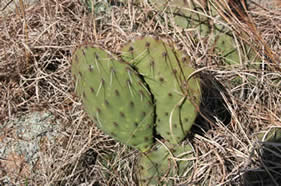Foods Indigenous to the Western Hemisphere
Prickly Pear Cactus

By Hugh Murphy
Common names: prickly pear, barbary pear, cactus pear, Indian fig and tuna fig.
The prickly pear cactus was and is a staple in the diets of many indigenous peoples of the southwestern United States and Mexico. While it is now grown throughout the dry regions of southern Europe, it is believed that all species of prickly pear cacti originated in North America where it became a valued source of food and medicine for centuries of people (Niethammer, 16).
Description
Prickly pear cacti grow in large, jumbled clumps of fleshy leaves called ‘pads’ or ‘nopales’. These nopales are flat, oblong shaped structures that are generally deep green in color. They are covered with needle-like spines or prickly, hair-like spines depending on the variety. These spines protect the plant from grazing animals and make the harvest of prickly pears somewhat tedious (Niethammer, 21).
Prickly pear fruit emerge from cactus nopales in the hottest, driest months of the year. They are small and oval in shape, with the largest fruits reaching 5” in length (Davidson, 634). Color ranges from yellowish-green to a deep-red or purple. Most fruits ripen to a deep-red color in late summer. These reddish fruits are generally regarded as the best for eating.
Like many nopales, prickly pear fruit (also called figs or tunas) are covered with needle-like spines. American Indians removed these spines by rubbing the fruit in the sand (Davidson, 635). This was made easier in the early mornings when the cacti were covered with dew. Today, spines are commonly removed by scrubbing each fruit with a vegetable brush under running water.
Uses:
Food
Prickly pear fruit was usually eaten fresh and raw by American Indians. Some tribes made candy and chewing gum from the fruit, or mashed the ‘tunas’ into a sort of applesauce. Mashed fruit was also boiled down into prickly pear syrup, juice or jelly (Davidson, 635). Excess fruit was dried and stored for winter.
The prickly pear fruits are not the only edible part of the cactus—young, green nopales can be sliced, boiled and eaten as a vegetable (Niethammer, 19). Nopale strips must be boiled to remove the gelatinous sap that allows the plant to retain water in through periods of drought.
Medicine
Prickly pear fruit and nopales were used by American Indians to treat a variety of physical ailments. Nopales in particular were split and applied to open wounds on both humans and animals (Scully, 292). Roasted nopales were held on the side of the neck or below the chin to treat rheumatism and mumps (Scully, 130). Tribes in New Mexico and the Baja region of California applied warm nopales to the body to reduce swelling (Niethammer, 21). Many tribes wrapped split, soaked pads over open wounds to speed recovery, and the Pima tribe used warm pads to increase milk flow in nursing women (Niethammer, 21).
Other Uses
Spines from prickly pear pads were commonly used as needles by many tribes (Scully, 130). The deep reds and purples of the tunas were extracted as juice and used to dye textiles (Frank, 79).
Photos:
http://upload.wikimedia.org/wikipedia/commons/2/22/Opuntia_littoralis_var_vaseyi_4.jpg
http://upload.wikimedia.org/wikipedia/en/d/df/Prickly_Pear_Closeup.jpg
Sources
Davidson, Alan. The Oxford Companion to Food. Oxford: Oxford University Press, 1999.
Frank, Lois Ellen. Native American Cooking – Foods of the Soutwest Indians Nations. New York: Clarkson Potter Publishers, 1991.
Niethammer, Carolyn. American Indian Food and Lore. New York: Macmillan Publishing Co., 1974.
Scully, Virginia. A Treasury of American Indian Herbs – Their Lore and Their Use for Food, Drugs, and Medicine. New York: Crown Publishers, Inc. 1970.
Traditional Indigenous Foods
History of Traditional Tribal FoodsFoods Indigenous to the Western Hemisphere
Geographic Areas
Foods of CaliforniaFoods of Great Basin
Foods of Mexico
Foods of Northwest
Foods of Peru
Foods of Plains
Foods of Plateau
Foods of Southwest
Foods of Subarctic
Foods of Texas